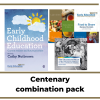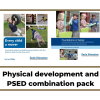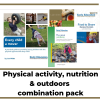Outdoors and Active
Outdoors and Active – an action research project commissioned by the London Borough of Newham – took practitioners from nurseries, schools, PVI settings and children’s
Busy modern lives are having a dramatic impact on the health and wellbeing of our youngest children. They play outdoors less, spend more time being transported in cars and pushchairs rather than walking, and are leading increasingly sedentary lives. At Newham, we wanted to tackle the rising obesity crisis in partnership with our early years settings, children and practitioners.
The British Heart Foundation and the UK’s four Chief Medical Officers all recommend children participate in at least three hours of physical activity; this should be spread across the whole day, and could be anything from walking up and down stairs or strolling to the shops through to playing football or running through long grass. Medium to vigorous activity is good for children’s physical health, mental wellbeing and overall development: human beings are hard-wired to move, and right from birth, babies show joy in their movements.
Regular and frequent activity helps children manage their bodies and their minds; it helps with problem solving, co-ordination, concentration, agility and strength. Children love repetition and by going back to familiar places and testing out favourite movements, they develop confidence and a positive attitude to personal safety and risk taking.
Children’s energy levels, musculoskeletal health (e.g. bones, joints) and mental health have all been proved to benefit from physical exercise. What’s perhaps not so obvious is the connection between children’s ability to swing or jump from a tree branch and their ability to write with a strong ‘tripod’ grip, or simply ‘be still’. Without the dexterity, resilience and strength to control the big muscle groups in their backs, children will find it almost impossible to sustain the tension in their upper arms, wrists and fingers that writing requires. Standing still requires control of every muscle in the body – just try it for a minute, and see how tiring it can be. So physically active play doesn’t just help keep young children fit and healthy, it helps them think, risk assess, plan and communicate.
What do we mean by “physical activity”?
Physical activity is bodily movement that results in a raised heart rate; the Outdoors and Active early years settings summarised this as children getting ‘puffed out and rosy cheeked’. The British Heart Foundation recommends that children get at least three hours of physical activity every day – and luckily, everyday activities such as gardening and walking count, as do recreational activities such as dancing, cycling or active outdoor play. Sport and exercise classes are at the ‘vigorous’ end of the activity spectrum, and whilst not many under 5s will be participating in aerobics or competitive gymnastics, they can gain many of the benefits of vigorous activity by enjoying extended periods of free, uninterrupted active play outdoors in the parks, gardens, playgrounds and streets of Newham.
What do we want children to do?
Starting with the belief that “all movements are good”, the Outdoors and Active early years settings worked with movement specialist Jasmine Pasch to establish the benefits of physical activity for their children. Jasmine’s “BoingWhooshRolyPoly” approach to developing balance helped us all to remember the different ways we could encourage children to move:
Children also need to develop strength, agility, dexterity, co-ordination, resilience, stamina, suppleness and flexibility. In combination, these qualities enable children to walk, run, carry, push, pull – and write. Jasmine Pasch talks about “bodyfulness” – akin to “mindfulness” for the body: paying attention and being conscious of movement, aware of our bodies and their extremities in the spaces they occupy. We need children to be in tune with the messages their body sends them – in tune, in fact, with their physicality, which is different from physical development milestones such as learning to walk.
For more ideas see our dedicated page on Boing, Whoosh and RolyPoly play, with Top Tips to download.
Where can we get children outdoors and active?
Newham is packed with parks, open spaces and urban environments for children and their carers to enjoy together. Physical activity isn’t just about organised sports or park play equipment; it’s about joy and skill in movement. Yet traditional play equipment is usually designed with physical development milestones in mind, rather than for children’s physicality or bodyfulness. Almost any place or space can be used to encourage children to move and use their bodies – even the features found on the streets, such as walls and benches, which we commonly ask children to “get off” or “leave alone”. These features are often particularly rich in opportunities for physicality and body confidence. You can view our handy interactive map, including a selection of spaces and what they contain below:
Outdoors and Active – an action research project commissioned by the London Borough of Newham – took practitioners from nurseries, schools, PVI settings and children’s
Little or no equipment is needed to get children active in the park – not even the play equipment that’s probably already there! If there is play
Even everyday journeys and mundane chores can be used to encourage children to be more physically active. Here are some ideas, suggested by the Outdoors
Toddlers need plenty of balance practice once they are up and walking. Each of the three semi-circular canals in the inner ear respond to movement in different
An early task for the Outdoors and Active action researchers was to identify the barriers to taking children out and about beyond the setting. Only
Human beings are “hardwired” to take risks, from birth. Babies take their first independent breaths; they decide to try crawling and walking and then running;
Traditional fixed play equipment is not necessary for physicality; if it’s there, then great – use it. Most of the Outdoors and Active project settings
Children can have fun and be active in any kind of landscape, but there’s no doubt that the more diverse and intriguing the space, the
To audit the current provision for physical development outdoors in your school or setting, you can download our three sample audit sheets below. You should
Are children at your setting moving enough? Do they enjoy plenty of physically active outdoor play? The Newham Outdoors and Active practitioners spent eight months
Some of the childminders involved in the Outdoors and Active project thought that a kit of easy to carry, low cost resources could encourage children









Early Education
2 Victoria Square
St Albans
AL1 3TF
T: 01727 884925
E: office@early-education.org.uk